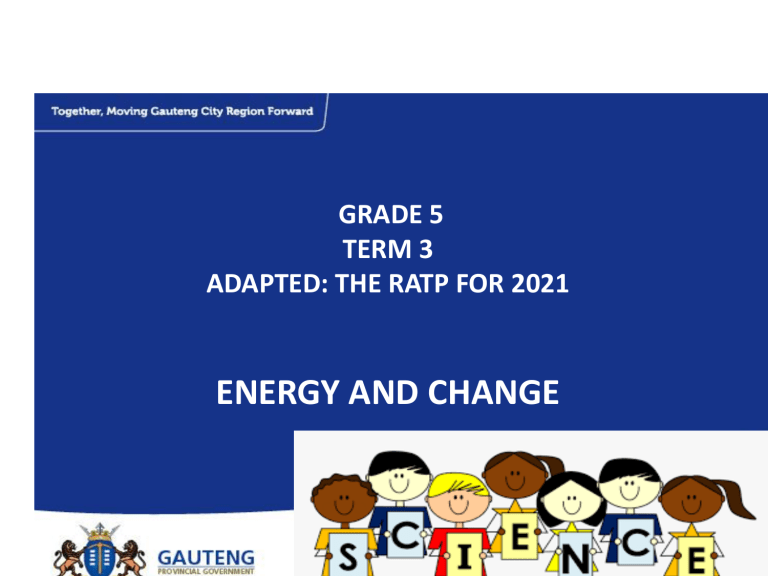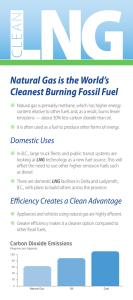
GRADE 5 TERM 3 ADAPTED: THE RATP FOR 2021 ENERGY AND CHANGE 1. STORED ENERGY IN FUELS (3 weeks) 1. FUELS Energy is stored in fuels We use energy every day. Energy is all around you. It is valuable and useful and makes our lives easier. If we did not have energy there would be nothing. There would be no life, no movement, no light and no heat. Energy helps us to do work. It is part of our daily lives, whether it is eating or doing homework or using a candle or listening to the radio. All these activities need energy, and this energy can come from fuel. Fuel is something that can be eaten or burned to make heat, light or movement. Energy is stored in fuel.1 Food is fuel for the body • Humans and animals need energy to live. We get our energy from the food that we eat. • We have learnt how energy from the Sun is used by plants to make food. • The plant uses the Sun’s energy to make its own food. • It stores the food in the leaves, roots, stems, flowers and fruit. • The energy remains stored until that part of the plant is eaten. It is sometimes called “fuel for the body”. • Food contains stored energy that our bodies can change into useful energy that we need when we run, jump, breathe, learn and do everything else that we do. Food is fuel for the body So, we can say that food is the fuel for our bodies! I must need a lot of fuel for my body as I love being active! The energy value of food is often shown on the packaging of foods that we buy. The energy of food is measured either in calories (Cal) or in joules (J). A snack such as a packet of chips gives you thousands of joules of energy. Therefore, we rather talk about kilojoules (kJ) of energy when talking about the energy in food. Have a look at the photo of the side of a mealie meal packet below. The side of the packet contains a lot of information about what the mealie meal contains. The very top line tells us that a 100 g of mealie meal will supply your body with 1368kJ of energy. Food is fuel for the body Nutritional information on a mealie meal packet. The energy value of a food tells us how much energy that food is worth to our bodies as fuel. An average adult man needs about 2 500kcal or 10 000 kJ per day. Children and adults that are not very active need less energy. People that are very active need more energy. These numbers are just to give us an idea of the amount of energy your body needs as fuel everyday. Activity. Energy from food Source: Thunderbolt Kids (5B) learner guide Refer to the activity on pg.9 and 10 Learners collect various packaging for foods and bring to school. More ideas for activities Source: GDE Gr.5 Lesson plans 2019 Refer to pg. 287,288 Fuels as sources of useful energy Some fuels can be burnt to create heat and light. Wood is often collected and burnt to give us heat and light. On a cold evening, it is wonderful to sit around a fire to tell stories and warm yourself with friends. A fire to provide heat or light. Cooking meat on a fire. Wood comes from plants, specifically trees. Plants use light energy from the Sun, as well as carbon dioxide and water to grow. Plants take the energy and store it in their leaves, roots and all parts of the plant. Wood also contains this energy stored by plants. burning wood allows us to change this stored energy into light and heat which is useful to us. Fuels as sources of useful energy Energy from the sun is stored in the tree's wood which is released as light and heat when we burn the wood. Coal is a type of fossil fuel that is also burnt to provide us with heat that we can use. The heat from coal can be used to cook our food and warm our houses. Fuels as sources of useful energy • • • • • • • • • • • • • Fossil fuels like coal were made from prehistoric plants. The plants got their energy from the Sun and stored it in their bodies. Millions of years ago, a lot of the Earth was covered by water. The plants that died sank to the bottom of the water. Over millions of years, the layers of plants were covered by layers of sand and pushed down by the weight of the sand. The plant material was buried deeper and deeper under the ground where it is much hotter than on the surface of the Earth. Over millions of years, the plant remains are changed into fossil fuels. Fossil fuels get their name "fossil" because they are made from plants and animals that were alive a long, long time ago. Other types of fossil fuels are natural gas and oil. Scientists have realized that tiny sea organisms, also died, sank to the bottom of the ocean and were buried under the sand. Over millions of years, many layers of dead sea animals got buried like this. Over millions of years, the dead sea animals changed into oil and natural gas. Fuels as sources of useful energy • • • • • • Wax in a candle is burnt to provide light. There is stored energy in the wax and burning it, allows us to change the stored energy into light. Burning candle Paraffin is also a fuel that contains stored energy. Paraffin is burnt in paraffin lamps and paraffin stoves to provide us with useful energy in the form of light and heat. Paraffin lamp Fuels as sources of useful energy Some fuels are energy sources for engines and power stations • Fuels can also be used to give us other forms of useful energy. • Petrol or diesel is used in cars and trucks to make them go. • The stored energy in the fuel is changed into movement energy of the car or truck. Petrol and diesel are made from fossil fuels. Can you see that even energy for cars and generating electricity comes from the Sun? Fuels as sources of useful energy • • Energy from the Sun is stored in the plants and animals which eat the plants. Their remains turned into fossil fuels over millions of years which are then used to make petrol and diesel to fuel cars. • • • Coal is not only burnt in our homes for cooking and keeping us warm. It can also be used to make electricity. 1 powerstation is a large factory where the coal is burnt in large amounts to produce electricity. Input an output energy – Practical investigation • • • • A candle needs a burning match to set its wick alight. The match is what we call input energy. This is the energy to be “put in” to start the fuel (candle) burning. When the candle start burning, the stored energy inside is released and changed to other forms of energy like heat and light. We call this output energy. How much energy can we get from different fuels? Source: Thunderbolt Kids (5B) learner guide Refer to the practical activity on pg. 11,12,13 14, Youtube video :https://youtu.be/uz6201OJ1Qo https://youtu.be/HO6twUJa5vE (burning a peanut) https://youtu.be/HO6twUJa5vE https://youtu.be/RHoVqQbOns4 (burning a dorito) Conclusion of above investigation • In order to light the fuel, you had to put in a small amount of energy. • The fuel however gave out a lot more energy than what was put in. • The difference between the energy you put in and the energy the fuel gave out is how much energy was stored in the fuel. • The OUTPUT Energy obtained from a fuel is GREATER than the INPUT Energy needed to make the fuel burn. More ideas for activities: Source: GDE Gr.5 Lesson plans 2019. Refer to pg. 289-296






